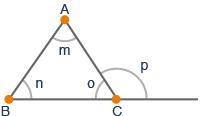
Mathematics, 17.11.2020 19:20 SmokeyRN
(02.07)A student writes an incorrect step while checking if the sum of the measures of the two remote interior angles of triangle ABC below is equal to the measure of the exterior angle.
A triangle ABC is shown. The base of the triangle extends into a straight line. The angle formed between this straight line and the edge of the triangle is marked as p. The angle adjacent to p is marked as o, and the other two angles inside the triangle are marked as m and n.
Step 1: m∠m + m∠n + m∠o = 180 degrees (sum of angles of a triangle)
Step 2: m∠p − m∠o = 90 degrees (alternate interior angles)
Step 3: Therefore, m∠m + m∠n + m∠o = m∠o + m∠p
Step 4: So, m∠m + m∠n = m∠p
In which step did the student first make a mistake and how can it be corrected?
Step 1; it should be m∠m + m∠n + m∠o = 90 degrees (corresponding angles)
Step 1; it should be m∠m + m∠n + m∠o = 90 degrees (adjacent angles)
Step 2; it should be m∠o + m∠p = 180 degrees (alternate exterior angles)
Step 2; it should be m∠o + m∠p = 180 degrees (supplementary angles)


Answers: 1
Another question on Mathematics

Mathematics, 21.06.2019 18:30
1.two more than the quotient of a number and 6 is equal to 7 use the c for the unknown number translate the sentence into an equation
Answers: 1

Mathematics, 21.06.2019 18:40
Juliana says that she can use the patterns of equivalent ratios in the multiplication table below to write an infinite number of ratios that are equivalent to 6: 10. which statement explains whether juliana is correct? she is correct because she can multiply 6 and 10 by any number to form an equivalent ratio. she is correct because 6: 10 can be written as 1: 2 and there are an infinite number of ratios for 1: 2. she is not correct because the multiplication table does not include multiples of 10. she is not correct because 6: 10 is equivalent to 3: 5 and there are only 9 ratios in the multiplication table that are equivalent to 3: 5.
Answers: 1

Mathematics, 21.06.2019 19:00
1c) the number 131 is a term in the sequence defined by the explicit rule f(n)=5n-4. which term in the sequence is 131? 2a) write the first four terms of the function f(n)=n^2-1 2b) what is the 10th term of the sequence defined by the explicit rule f(n)=n^2-1 2c) the number 224 is a term in the sequence defined by the explicit rule f(n)=n^2-1. which term in the sequence is 224?
Answers: 2

Mathematics, 21.06.2019 19:40
Ascatter plot with a trend line is shown below. which equation best represents the given data? y = x + 2 y = x + 5 y = 2x + 5
Answers: 1
You know the right answer?
(02.07)A student writes an incorrect step while checking if the sum of the measures of the two remot...
Questions

Arts, 22.01.2021 18:10

Mathematics, 22.01.2021 18:10

Mathematics, 22.01.2021 18:10

Mathematics, 22.01.2021 18:10


Health, 22.01.2021 18:10

Mathematics, 22.01.2021 18:10



Mathematics, 22.01.2021 18:10



Mathematics, 22.01.2021 18:10

Biology, 22.01.2021 18:10

Mathematics, 22.01.2021 18:10





Mathematics, 22.01.2021 18:10



